Financial Reporting Analysis: Rita PLC, IFRS, and Stakeholder Impact
VerifiedAdded on 2020/07/22
|12
|3097
|63
Report
AI Summary
This report provides a comprehensive analysis of financial reporting, focusing on the conceptual and regulatory framework of International Financial Reporting Standards (IFRS). It explores the purpose and key principles of the IFRS framework, emphasizing its role in providing relevant and reliable financial information to various stakeholders, including investors, creditors, and employees. The report identifies and discusses the main stakeholders of an organization, highlighting the importance of financial information in their decision-making processes. Furthermore, it presents the financial statements of Rita PLC, including an income statement, statement of changes in equity, and balance sheet, along with detailed working notes. The report also includes an analysis of the financial performance of Inter-Continental Group hotel, using liquidity, profitability, and solvency ratios to assess its financial health. Finally, the report sheds light on the differences between IFRS and IAS and the importance of financial reporting objectives.
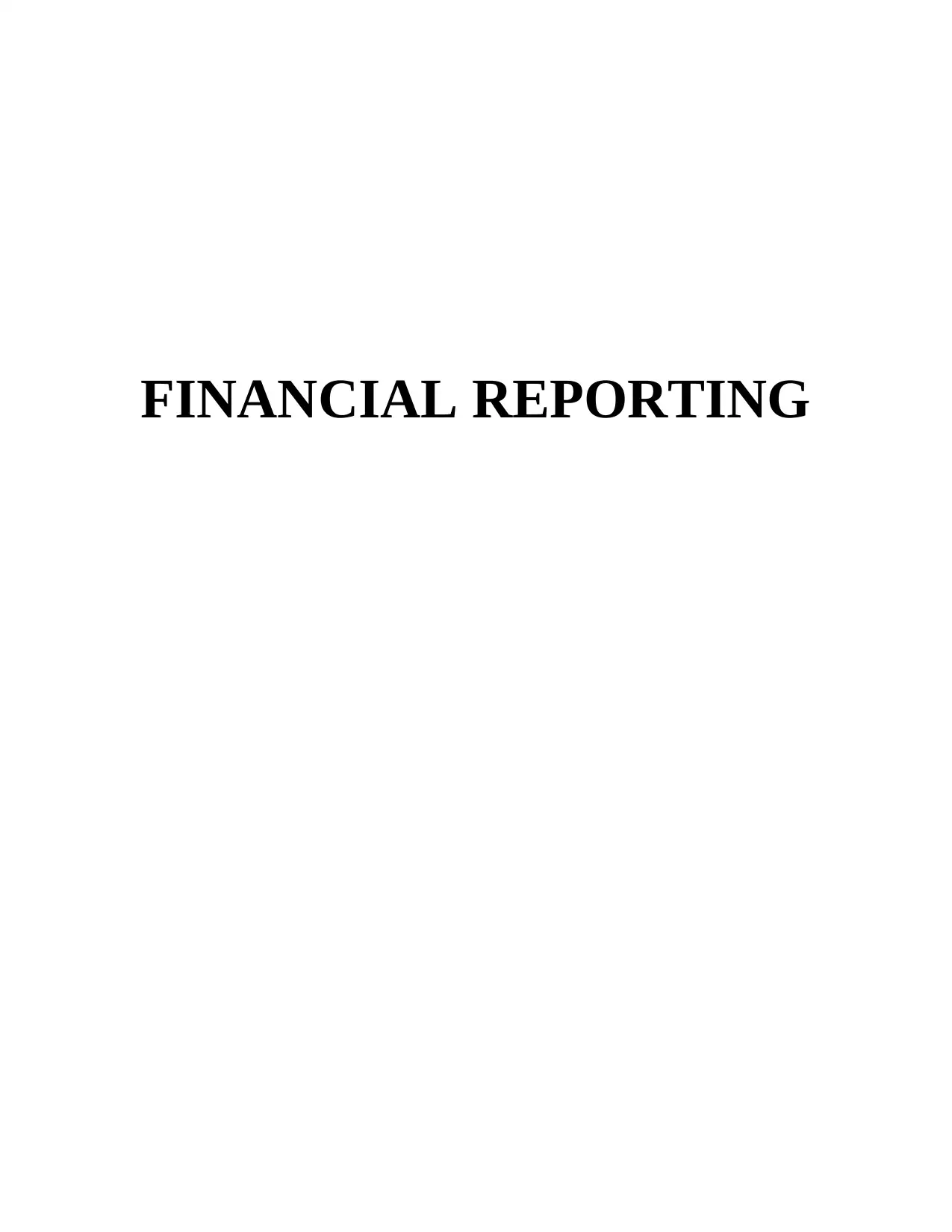
FINANCIAL REPORTING
Paraphrase This Document
Need a fresh take? Get an instant paraphrase of this document with our AI Paraphraser
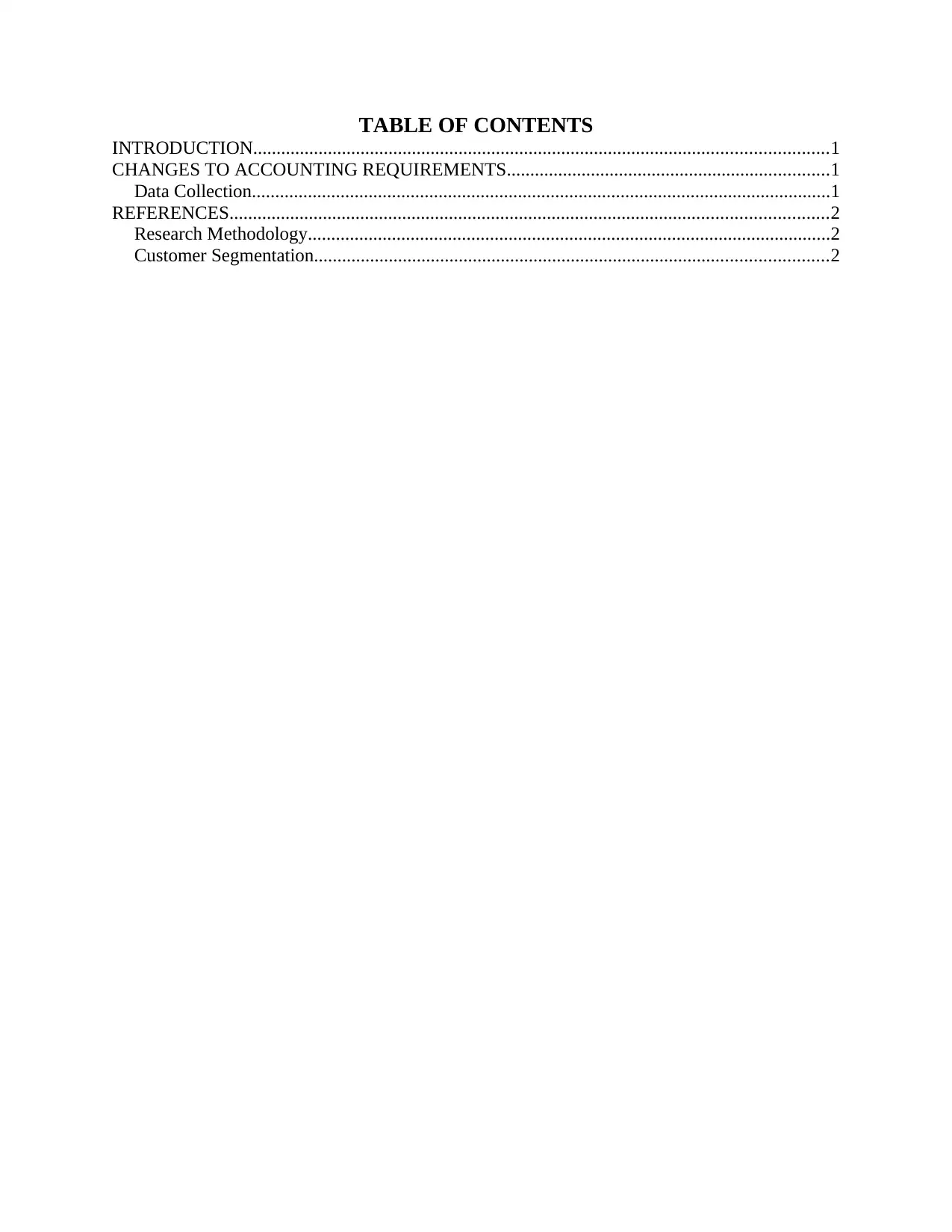
TABLE OF CONTENTS
INTRODUCTION...........................................................................................................................1
CHANGES TO ACCOUNTING REQUIREMENTS.....................................................................1
Data Collection............................................................................................................................1
REFERENCES................................................................................................................................2
Research Methodology................................................................................................................2
Customer Segmentation..............................................................................................................2
INTRODUCTION...........................................................................................................................1
CHANGES TO ACCOUNTING REQUIREMENTS.....................................................................1
Data Collection............................................................................................................................1
REFERENCES................................................................................................................................2
Research Methodology................................................................................................................2
Customer Segmentation..............................................................................................................2
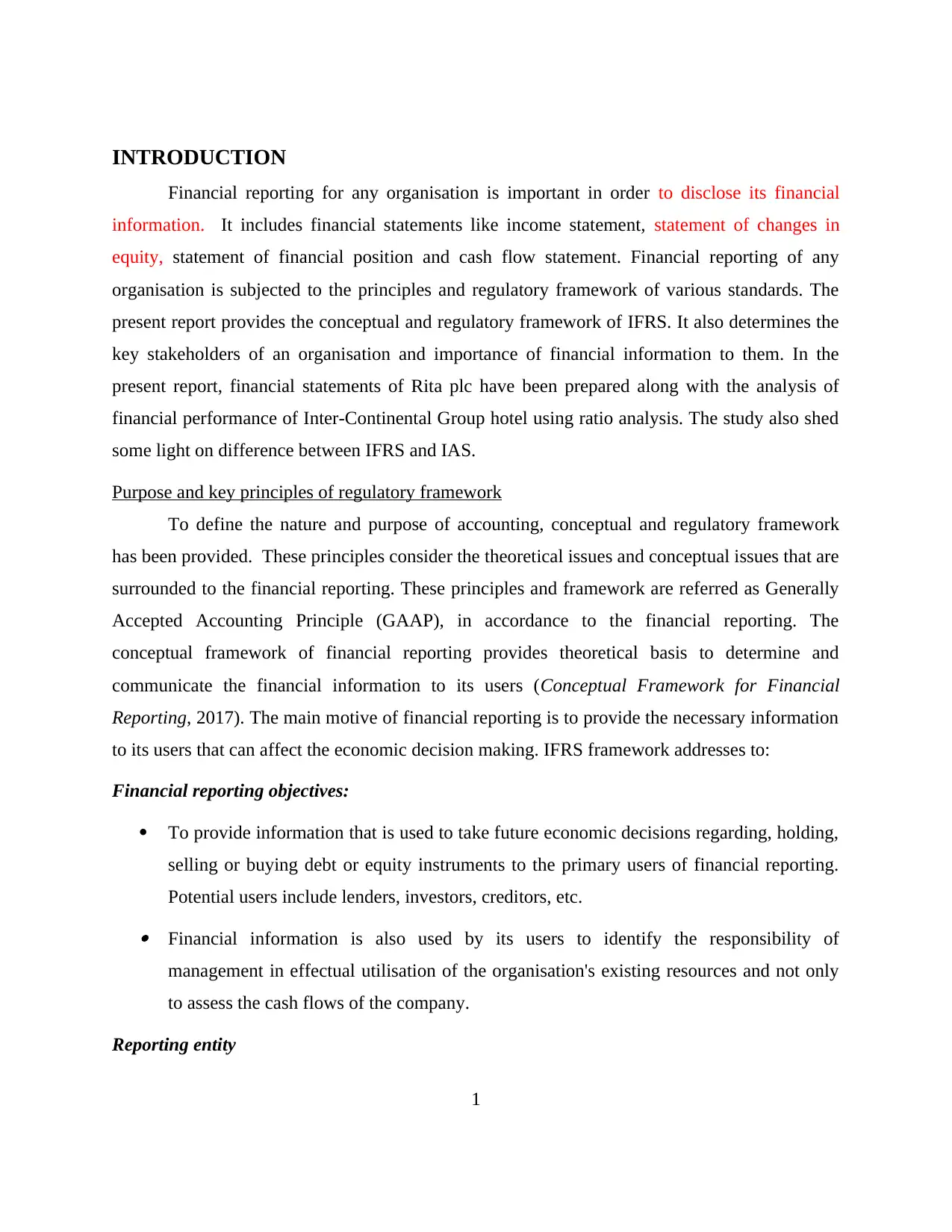
INTRODUCTION
Financial reporting for any organisation is important in order to disclose its financial
information. It includes financial statements like income statement, statement of changes in
equity, statement of financial position and cash flow statement. Financial reporting of any
organisation is subjected to the principles and regulatory framework of various standards. The
present report provides the conceptual and regulatory framework of IFRS. It also determines the
key stakeholders of an organisation and importance of financial information to them. In the
present report, financial statements of Rita plc have been prepared along with the analysis of
financial performance of Inter-Continental Group hotel using ratio analysis. The study also shed
some light on difference between IFRS and IAS.
Purpose and key principles of regulatory framework
To define the nature and purpose of accounting, conceptual and regulatory framework
has been provided. These principles consider the theoretical issues and conceptual issues that are
surrounded to the financial reporting. These principles and framework are referred as Generally
Accepted Accounting Principle (GAAP), in accordance to the financial reporting. The
conceptual framework of financial reporting provides theoretical basis to determine and
communicate the financial information to its users (Conceptual Framework for Financial
Reporting, 2017). The main motive of financial reporting is to provide the necessary information
to its users that can affect the economic decision making. IFRS framework addresses to:
Financial reporting objectives:
To provide information that is used to take future economic decisions regarding, holding,
selling or buying debt or equity instruments to the primary users of financial reporting.
Potential users include lenders, investors, creditors, etc. Financial information is also used by its users to identify the responsibility of
management in effectual utilisation of the organisation's existing resources and not only
to assess the cash flows of the company.
Reporting entity
1
Financial reporting for any organisation is important in order to disclose its financial
information. It includes financial statements like income statement, statement of changes in
equity, statement of financial position and cash flow statement. Financial reporting of any
organisation is subjected to the principles and regulatory framework of various standards. The
present report provides the conceptual and regulatory framework of IFRS. It also determines the
key stakeholders of an organisation and importance of financial information to them. In the
present report, financial statements of Rita plc have been prepared along with the analysis of
financial performance of Inter-Continental Group hotel using ratio analysis. The study also shed
some light on difference between IFRS and IAS.
Purpose and key principles of regulatory framework
To define the nature and purpose of accounting, conceptual and regulatory framework
has been provided. These principles consider the theoretical issues and conceptual issues that are
surrounded to the financial reporting. These principles and framework are referred as Generally
Accepted Accounting Principle (GAAP), in accordance to the financial reporting. The
conceptual framework of financial reporting provides theoretical basis to determine and
communicate the financial information to its users (Conceptual Framework for Financial
Reporting, 2017). The main motive of financial reporting is to provide the necessary information
to its users that can affect the economic decision making. IFRS framework addresses to:
Financial reporting objectives:
To provide information that is used to take future economic decisions regarding, holding,
selling or buying debt or equity instruments to the primary users of financial reporting.
Potential users include lenders, investors, creditors, etc. Financial information is also used by its users to identify the responsibility of
management in effectual utilisation of the organisation's existing resources and not only
to assess the cash flows of the company.
Reporting entity
1
⊘ This is a preview!⊘
Do you want full access?
Subscribe today to unlock all pages.

Trusted by 1+ million students worldwide
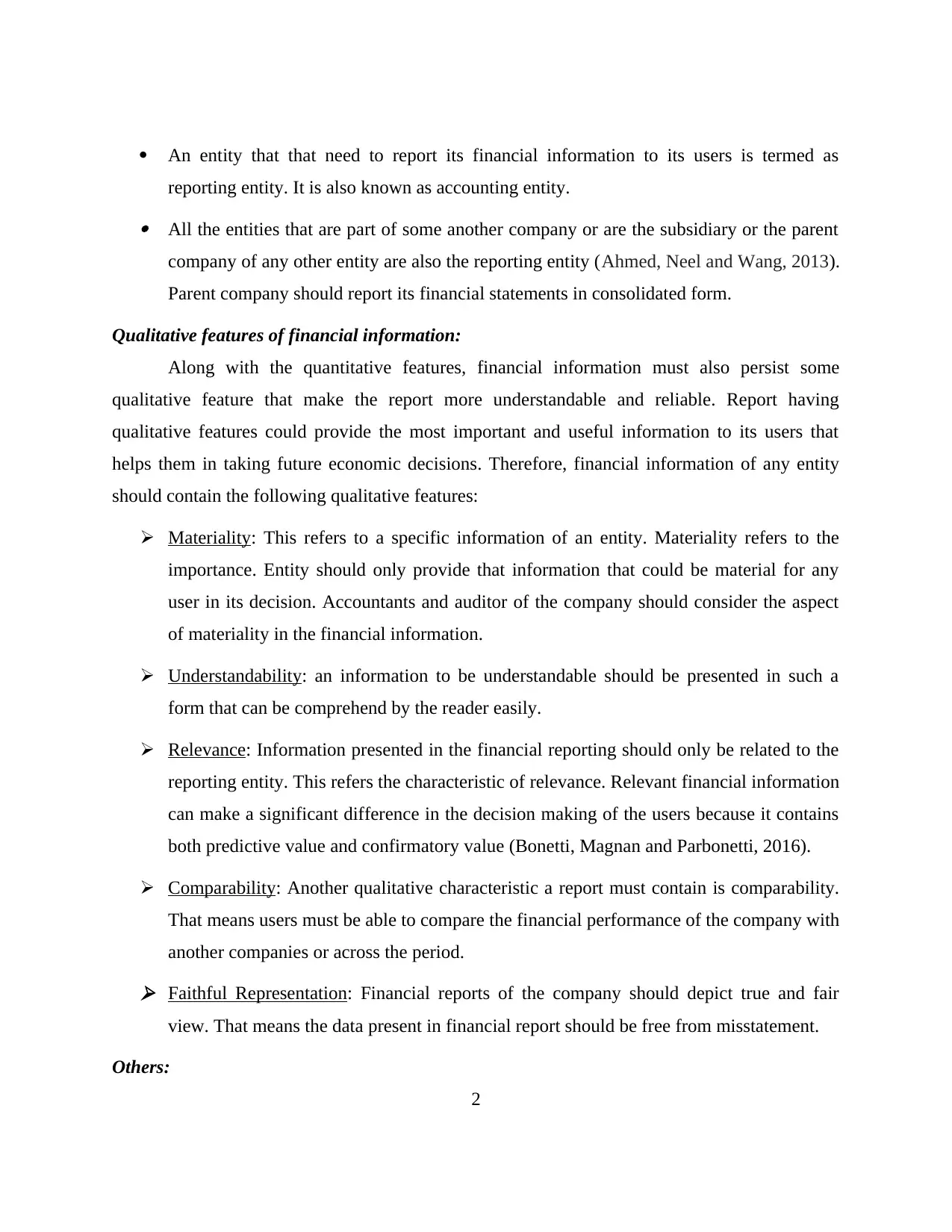
An entity that that need to report its financial information to its users is termed as
reporting entity. It is also known as accounting entity. All the entities that are part of some another company or are the subsidiary or the parent
company of any other entity are also the reporting entity (Ahmed, Neel and Wang, 2013).
Parent company should report its financial statements in consolidated form.
Qualitative features of financial information:
Along with the quantitative features, financial information must also persist some
qualitative feature that make the report more understandable and reliable. Report having
qualitative features could provide the most important and useful information to its users that
helps them in taking future economic decisions. Therefore, financial information of any entity
should contain the following qualitative features:
Materiality: This refers to a specific information of an entity. Materiality refers to the
importance. Entity should only provide that information that could be material for any
user in its decision. Accountants and auditor of the company should consider the aspect
of materiality in the financial information.
Understandability: an information to be understandable should be presented in such a
form that can be comprehend by the reader easily.
Relevance: Information presented in the financial reporting should only be related to the
reporting entity. This refers the characteristic of relevance. Relevant financial information
can make a significant difference in the decision making of the users because it contains
both predictive value and confirmatory value (Bonetti, Magnan and Parbonetti, 2016).
Comparability: Another qualitative characteristic a report must contain is comparability.
That means users must be able to compare the financial performance of the company with
another companies or across the period. Faithful Representation: Financial reports of the company should depict true and fair
view. That means the data present in financial report should be free from misstatement.
Others:
2
reporting entity. It is also known as accounting entity. All the entities that are part of some another company or are the subsidiary or the parent
company of any other entity are also the reporting entity (Ahmed, Neel and Wang, 2013).
Parent company should report its financial statements in consolidated form.
Qualitative features of financial information:
Along with the quantitative features, financial information must also persist some
qualitative feature that make the report more understandable and reliable. Report having
qualitative features could provide the most important and useful information to its users that
helps them in taking future economic decisions. Therefore, financial information of any entity
should contain the following qualitative features:
Materiality: This refers to a specific information of an entity. Materiality refers to the
importance. Entity should only provide that information that could be material for any
user in its decision. Accountants and auditor of the company should consider the aspect
of materiality in the financial information.
Understandability: an information to be understandable should be presented in such a
form that can be comprehend by the reader easily.
Relevance: Information presented in the financial reporting should only be related to the
reporting entity. This refers the characteristic of relevance. Relevant financial information
can make a significant difference in the decision making of the users because it contains
both predictive value and confirmatory value (Bonetti, Magnan and Parbonetti, 2016).
Comparability: Another qualitative characteristic a report must contain is comparability.
That means users must be able to compare the financial performance of the company with
another companies or across the period. Faithful Representation: Financial reports of the company should depict true and fair
view. That means the data present in financial report should be free from misstatement.
Others:
2
Paraphrase This Document
Need a fresh take? Get an instant paraphrase of this document with our AI Paraphraser
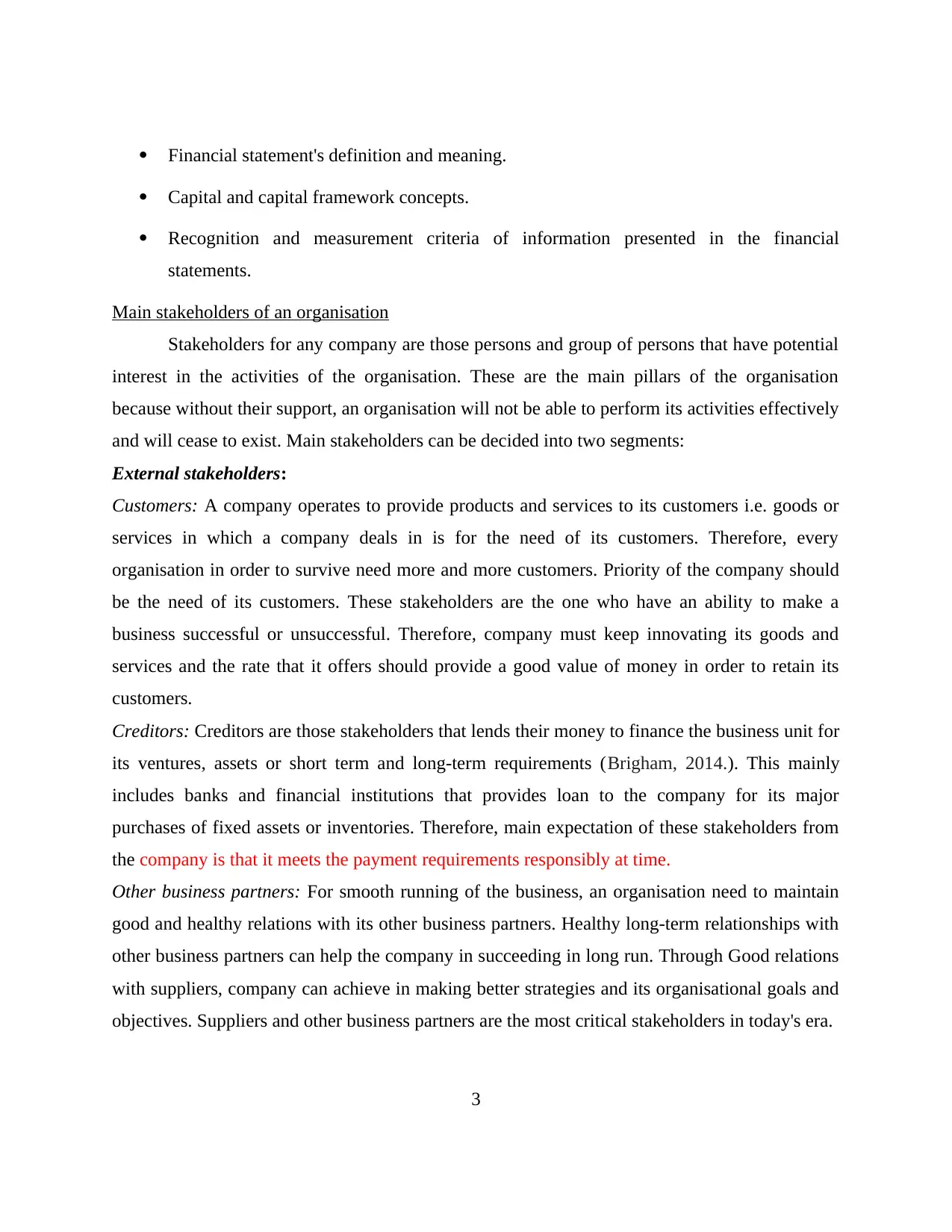
Financial statement's definition and meaning.
Capital and capital framework concepts.
Recognition and measurement criteria of information presented in the financial
statements.
Main stakeholders of an organisation
Stakeholders for any company are those persons and group of persons that have potential
interest in the activities of the organisation. These are the main pillars of the organisation
because without their support, an organisation will not be able to perform its activities effectively
and will cease to exist. Main stakeholders can be decided into two segments:
External stakeholders:
Customers: A company operates to provide products and services to its customers i.e. goods or
services in which a company deals in is for the need of its customers. Therefore, every
organisation in order to survive need more and more customers. Priority of the company should
be the need of its customers. These stakeholders are the one who have an ability to make a
business successful or unsuccessful. Therefore, company must keep innovating its goods and
services and the rate that it offers should provide a good value of money in order to retain its
customers.
Creditors: Creditors are those stakeholders that lends their money to finance the business unit for
its ventures, assets or short term and long-term requirements (Brigham, 2014.). This mainly
includes banks and financial institutions that provides loan to the company for its major
purchases of fixed assets or inventories. Therefore, main expectation of these stakeholders from
the company is that it meets the payment requirements responsibly at time.
Other business partners: For smooth running of the business, an organisation need to maintain
good and healthy relations with its other business partners. Healthy long-term relationships with
other business partners can help the company in succeeding in long run. Through Good relations
with suppliers, company can achieve in making better strategies and its organisational goals and
objectives. Suppliers and other business partners are the most critical stakeholders in today's era.
3
Capital and capital framework concepts.
Recognition and measurement criteria of information presented in the financial
statements.
Main stakeholders of an organisation
Stakeholders for any company are those persons and group of persons that have potential
interest in the activities of the organisation. These are the main pillars of the organisation
because without their support, an organisation will not be able to perform its activities effectively
and will cease to exist. Main stakeholders can be decided into two segments:
External stakeholders:
Customers: A company operates to provide products and services to its customers i.e. goods or
services in which a company deals in is for the need of its customers. Therefore, every
organisation in order to survive need more and more customers. Priority of the company should
be the need of its customers. These stakeholders are the one who have an ability to make a
business successful or unsuccessful. Therefore, company must keep innovating its goods and
services and the rate that it offers should provide a good value of money in order to retain its
customers.
Creditors: Creditors are those stakeholders that lends their money to finance the business unit for
its ventures, assets or short term and long-term requirements (Brigham, 2014.). This mainly
includes banks and financial institutions that provides loan to the company for its major
purchases of fixed assets or inventories. Therefore, main expectation of these stakeholders from
the company is that it meets the payment requirements responsibly at time.
Other business partners: For smooth running of the business, an organisation need to maintain
good and healthy relations with its other business partners. Healthy long-term relationships with
other business partners can help the company in succeeding in long run. Through Good relations
with suppliers, company can achieve in making better strategies and its organisational goals and
objectives. Suppliers and other business partners are the most critical stakeholders in today's era.
3
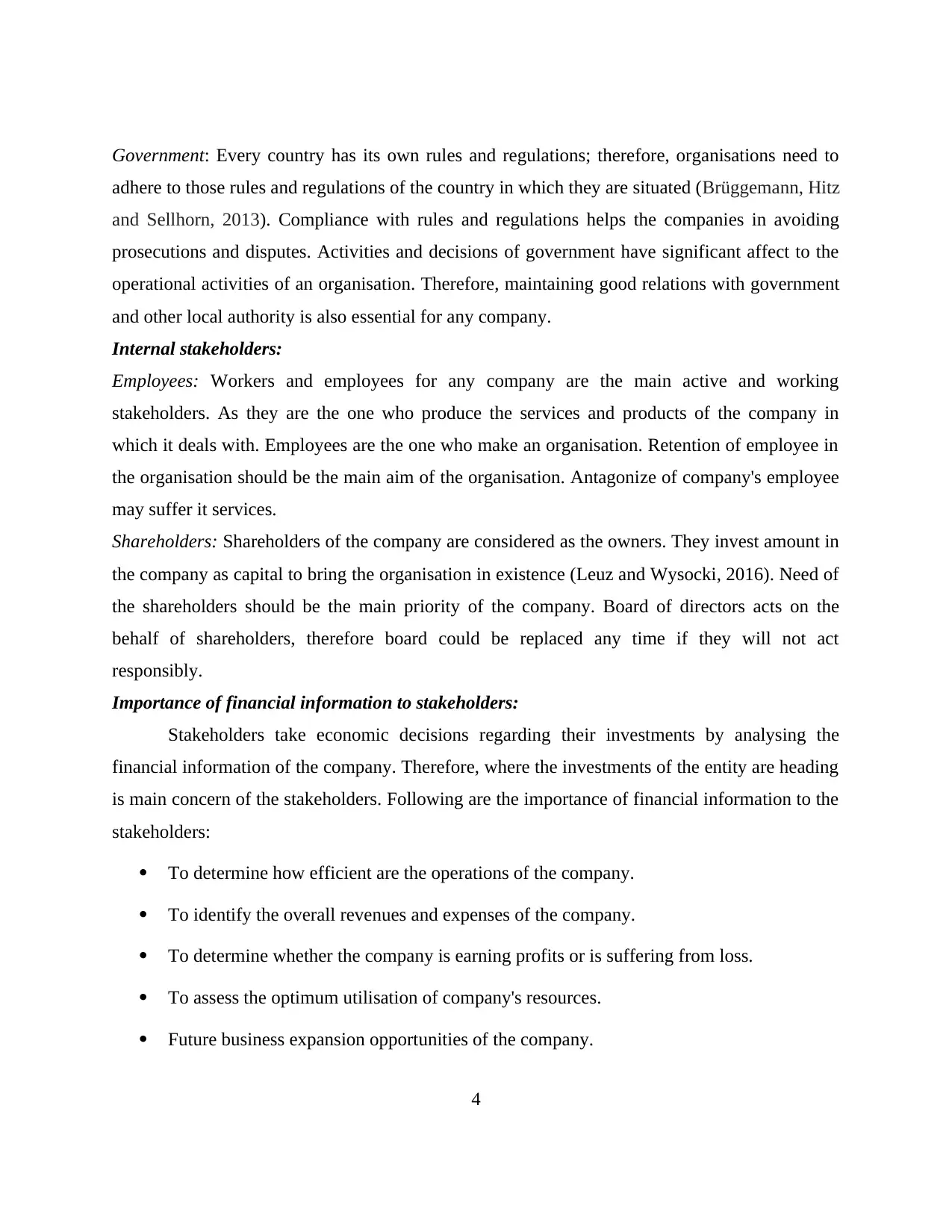
Government: Every country has its own rules and regulations; therefore, organisations need to
adhere to those rules and regulations of the country in which they are situated (Brüggemann, Hitz
and Sellhorn, 2013). Compliance with rules and regulations helps the companies in avoiding
prosecutions and disputes. Activities and decisions of government have significant affect to the
operational activities of an organisation. Therefore, maintaining good relations with government
and other local authority is also essential for any company.
Internal stakeholders:
Employees: Workers and employees for any company are the main active and working
stakeholders. As they are the one who produce the services and products of the company in
which it deals with. Employees are the one who make an organisation. Retention of employee in
the organisation should be the main aim of the organisation. Antagonize of company's employee
may suffer it services.
Shareholders: Shareholders of the company are considered as the owners. They invest amount in
the company as capital to bring the organisation in existence (Leuz and Wysocki, 2016). Need of
the shareholders should be the main priority of the company. Board of directors acts on the
behalf of shareholders, therefore board could be replaced any time if they will not act
responsibly.
Importance of financial information to stakeholders:
Stakeholders take economic decisions regarding their investments by analysing the
financial information of the company. Therefore, where the investments of the entity are heading
is main concern of the stakeholders. Following are the importance of financial information to the
stakeholders:
To determine how efficient are the operations of the company.
To identify the overall revenues and expenses of the company.
To determine whether the company is earning profits or is suffering from loss.
To assess the optimum utilisation of company's resources.
Future business expansion opportunities of the company.
4
adhere to those rules and regulations of the country in which they are situated (Brüggemann, Hitz
and Sellhorn, 2013). Compliance with rules and regulations helps the companies in avoiding
prosecutions and disputes. Activities and decisions of government have significant affect to the
operational activities of an organisation. Therefore, maintaining good relations with government
and other local authority is also essential for any company.
Internal stakeholders:
Employees: Workers and employees for any company are the main active and working
stakeholders. As they are the one who produce the services and products of the company in
which it deals with. Employees are the one who make an organisation. Retention of employee in
the organisation should be the main aim of the organisation. Antagonize of company's employee
may suffer it services.
Shareholders: Shareholders of the company are considered as the owners. They invest amount in
the company as capital to bring the organisation in existence (Leuz and Wysocki, 2016). Need of
the shareholders should be the main priority of the company. Board of directors acts on the
behalf of shareholders, therefore board could be replaced any time if they will not act
responsibly.
Importance of financial information to stakeholders:
Stakeholders take economic decisions regarding their investments by analysing the
financial information of the company. Therefore, where the investments of the entity are heading
is main concern of the stakeholders. Following are the importance of financial information to the
stakeholders:
To determine how efficient are the operations of the company.
To identify the overall revenues and expenses of the company.
To determine whether the company is earning profits or is suffering from loss.
To assess the optimum utilisation of company's resources.
Future business expansion opportunities of the company.
4
⊘ This is a preview!⊘
Do you want full access?
Subscribe today to unlock all pages.

Trusted by 1+ million students worldwide
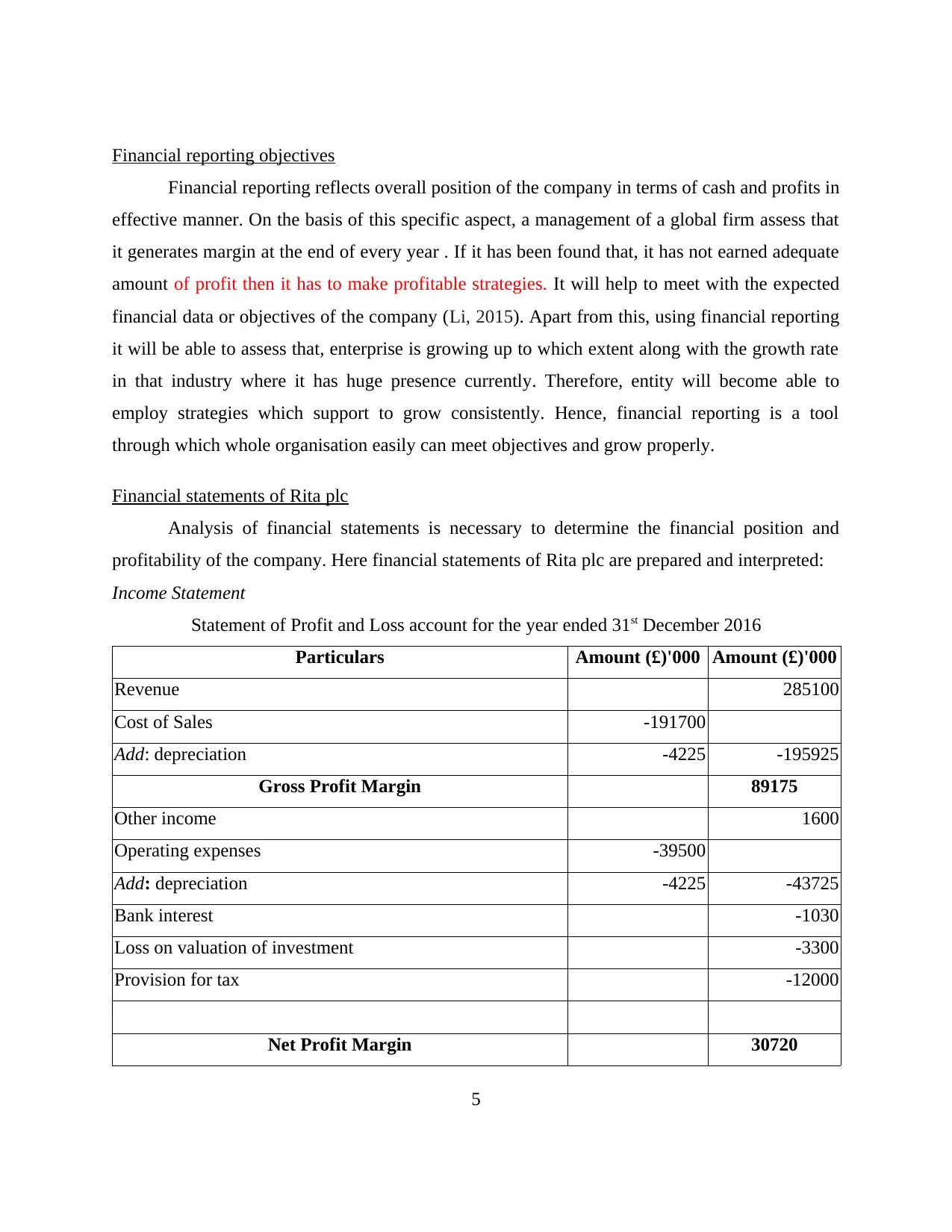
Financial reporting objectives
Financial reporting reflects overall position of the company in terms of cash and profits in
effective manner. On the basis of this specific aspect, a management of a global firm assess that
it generates margin at the end of every year . If it has been found that, it has not earned adequate
amount of profit then it has to make profitable strategies. It will help to meet with the expected
financial data or objectives of the company (Li, 2015). Apart from this, using financial reporting
it will be able to assess that, enterprise is growing up to which extent along with the growth rate
in that industry where it has huge presence currently. Therefore, entity will become able to
employ strategies which support to grow consistently. Hence, financial reporting is a tool
through which whole organisation easily can meet objectives and grow properly.
Financial statements of Rita plc
Analysis of financial statements is necessary to determine the financial position and
profitability of the company. Here financial statements of Rita plc are prepared and interpreted:
Income Statement
Statement of Profit and Loss account for the year ended 31st December 2016
Particulars Amount (£)'000 Amount (£)'000
Revenue 285100
Cost of Sales -191700
Add: depreciation -4225 -195925
Gross Profit Margin 89175
Other income 1600
Operating expenses -39500
Add: depreciation -4225 -43725
Bank interest -1030
Loss on valuation of investment -3300
Provision for tax -12000
Net Profit Margin 30720
5
Financial reporting reflects overall position of the company in terms of cash and profits in
effective manner. On the basis of this specific aspect, a management of a global firm assess that
it generates margin at the end of every year . If it has been found that, it has not earned adequate
amount of profit then it has to make profitable strategies. It will help to meet with the expected
financial data or objectives of the company (Li, 2015). Apart from this, using financial reporting
it will be able to assess that, enterprise is growing up to which extent along with the growth rate
in that industry where it has huge presence currently. Therefore, entity will become able to
employ strategies which support to grow consistently. Hence, financial reporting is a tool
through which whole organisation easily can meet objectives and grow properly.
Financial statements of Rita plc
Analysis of financial statements is necessary to determine the financial position and
profitability of the company. Here financial statements of Rita plc are prepared and interpreted:
Income Statement
Statement of Profit and Loss account for the year ended 31st December 2016
Particulars Amount (£)'000 Amount (£)'000
Revenue 285100
Cost of Sales -191700
Add: depreciation -4225 -195925
Gross Profit Margin 89175
Other income 1600
Operating expenses -39500
Add: depreciation -4225 -43725
Bank interest -1030
Loss on valuation of investment -3300
Provision for tax -12000
Net Profit Margin 30720
5
Paraphrase This Document
Need a fresh take? Get an instant paraphrase of this document with our AI Paraphraser
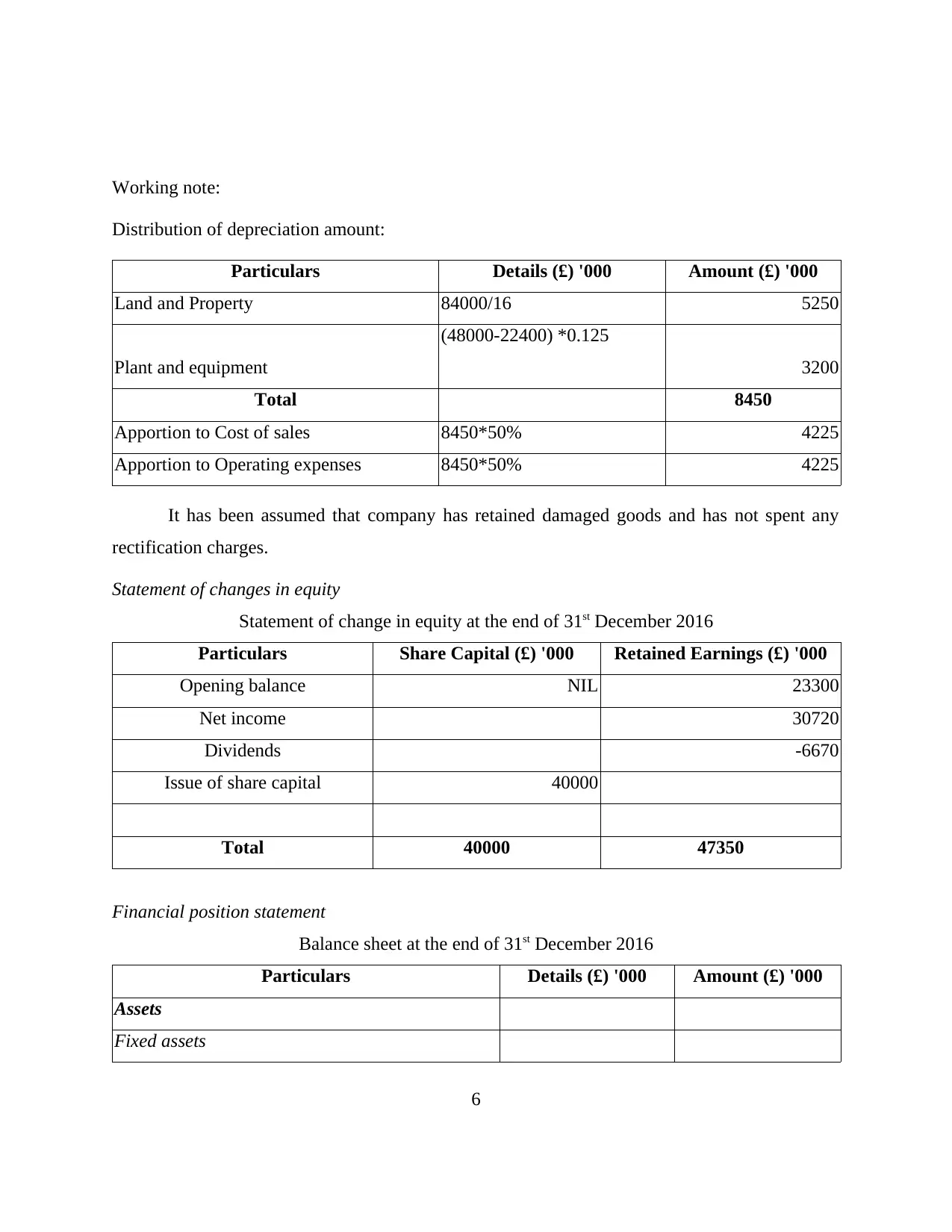
Working note:
Distribution of depreciation amount:
Particulars Details (£) '000 Amount (£) '000
Land and Property 84000/16 5250
Plant and equipment
(48000-22400) *0.125
3200
Total 8450
Apportion to Cost of sales 8450*50% 4225
Apportion to Operating expenses 8450*50% 4225
It has been assumed that company has retained damaged goods and has not spent any
rectification charges.
Statement of changes in equity
Statement of change in equity at the end of 31st December 2016
Particulars Share Capital (£) '000 Retained Earnings (£) '000
Opening balance NIL 23300
Net income 30720
Dividends -6670
Issue of share capital 40000
Total 40000 47350
Financial position statement
Balance sheet at the end of 31st December 2016
Particulars Details (£) '000 Amount (£) '000
Assets
Fixed assets
6
Distribution of depreciation amount:
Particulars Details (£) '000 Amount (£) '000
Land and Property 84000/16 5250
Plant and equipment
(48000-22400) *0.125
3200
Total 8450
Apportion to Cost of sales 8450*50% 4225
Apportion to Operating expenses 8450*50% 4225
It has been assumed that company has retained damaged goods and has not spent any
rectification charges.
Statement of changes in equity
Statement of change in equity at the end of 31st December 2016
Particulars Share Capital (£) '000 Retained Earnings (£) '000
Opening balance NIL 23300
Net income 30720
Dividends -6670
Issue of share capital 40000
Total 40000 47350
Financial position statement
Balance sheet at the end of 31st December 2016
Particulars Details (£) '000 Amount (£) '000
Assets
Fixed assets
6
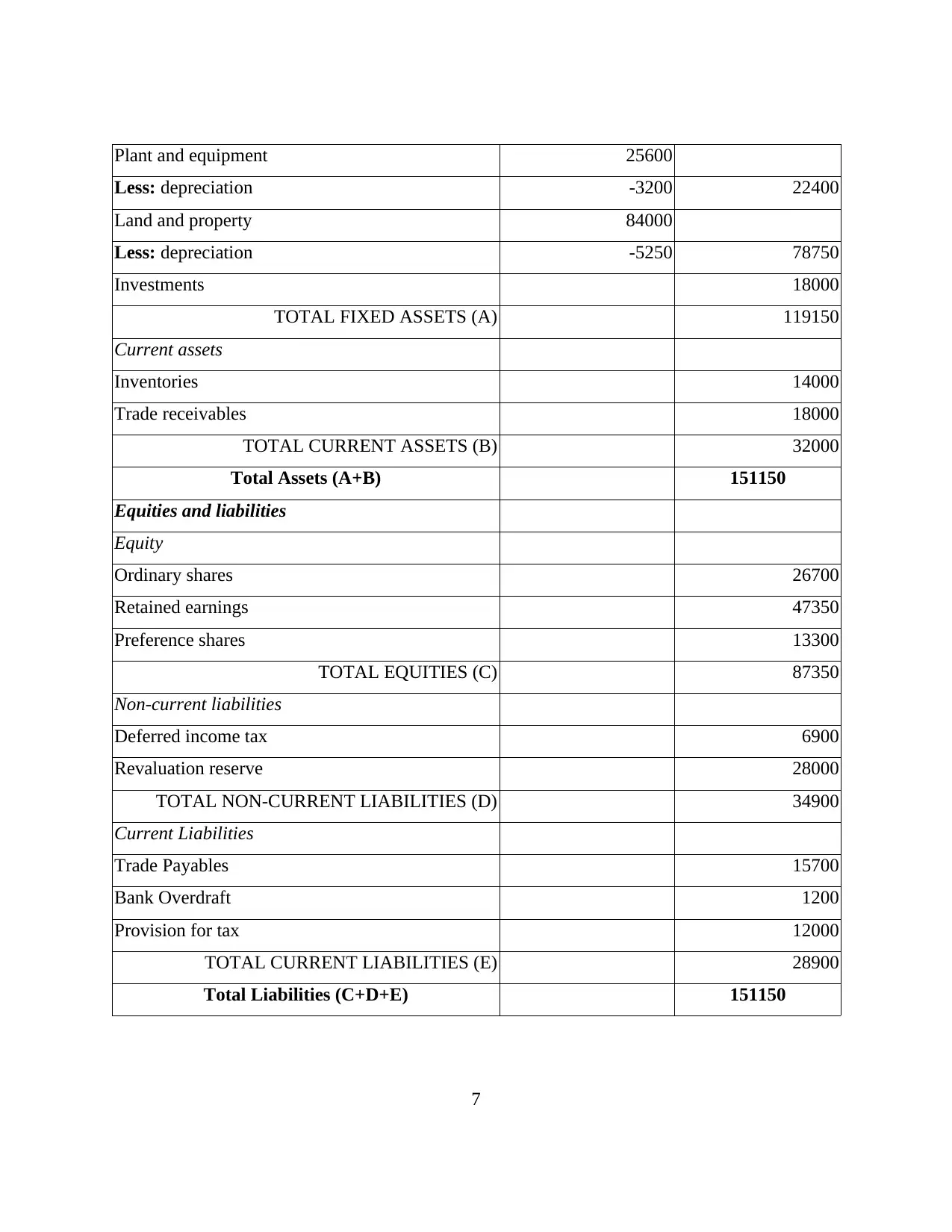
Plant and equipment 25600
Less: depreciation -3200 22400
Land and property 84000
Less: depreciation -5250 78750
Investments 18000
TOTAL FIXED ASSETS (A) 119150
Current assets
Inventories 14000
Trade receivables 18000
TOTAL CURRENT ASSETS (B) 32000
Total Assets (A+B) 151150
Equities and liabilities
Equity
Ordinary shares 26700
Retained earnings 47350
Preference shares 13300
TOTAL EQUITIES (C) 87350
Non-current liabilities
Deferred income tax 6900
Revaluation reserve 28000
TOTAL NON-CURRENT LIABILITIES (D) 34900
Current Liabilities
Trade Payables 15700
Bank Overdraft 1200
Provision for tax 12000
TOTAL CURRENT LIABILITIES (E) 28900
Total Liabilities (C+D+E) 151150
7
Less: depreciation -3200 22400
Land and property 84000
Less: depreciation -5250 78750
Investments 18000
TOTAL FIXED ASSETS (A) 119150
Current assets
Inventories 14000
Trade receivables 18000
TOTAL CURRENT ASSETS (B) 32000
Total Assets (A+B) 151150
Equities and liabilities
Equity
Ordinary shares 26700
Retained earnings 47350
Preference shares 13300
TOTAL EQUITIES (C) 87350
Non-current liabilities
Deferred income tax 6900
Revaluation reserve 28000
TOTAL NON-CURRENT LIABILITIES (D) 34900
Current Liabilities
Trade Payables 15700
Bank Overdraft 1200
Provision for tax 12000
TOTAL CURRENT LIABILITIES (E) 28900
Total Liabilities (C+D+E) 151150
7
⊘ This is a preview!⊘
Do you want full access?
Subscribe today to unlock all pages.

Trusted by 1+ million students worldwide
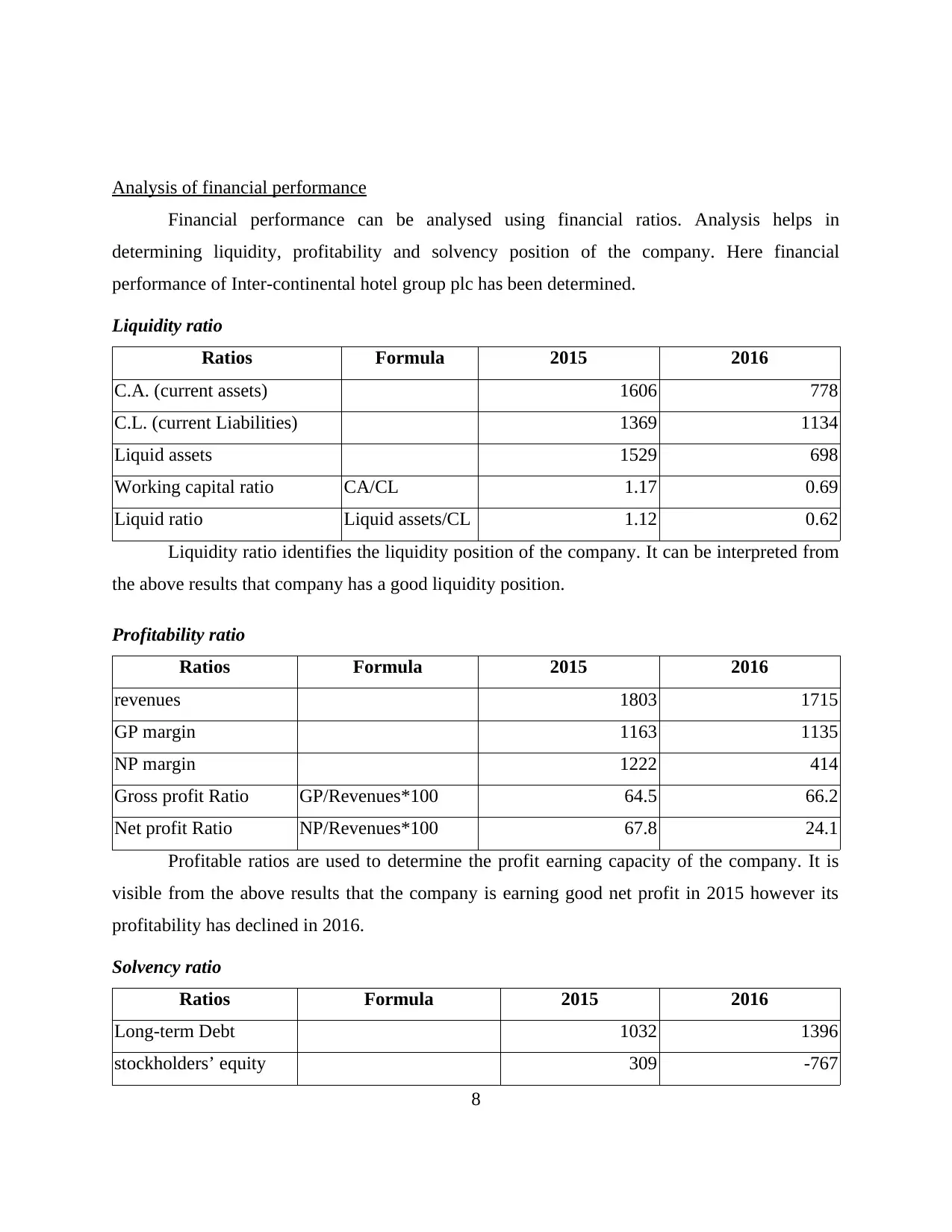
Analysis of financial performance
Financial performance can be analysed using financial ratios. Analysis helps in
determining liquidity, profitability and solvency position of the company. Here financial
performance of Inter-continental hotel group plc has been determined.
Liquidity ratio
Ratios Formula 2015 2016
C.A. (current assets) 1606 778
C.L. (current Liabilities) 1369 1134
Liquid assets 1529 698
Working capital ratio CA/CL 1.17 0.69
Liquid ratio Liquid assets/CL 1.12 0.62
Liquidity ratio identifies the liquidity position of the company. It can be interpreted from
the above results that company has a good liquidity position.
Profitability ratio
Ratios Formula 2015 2016
revenues 1803 1715
GP margin 1163 1135
NP margin 1222 414
Gross profit Ratio GP/Revenues*100 64.5 66.2
Net profit Ratio NP/Revenues*100 67.8 24.1
Profitable ratios are used to determine the profit earning capacity of the company. It is
visible from the above results that the company is earning good net profit in 2015 however its
profitability has declined in 2016.
Solvency ratio
Ratios Formula 2015 2016
Long-term Debt 1032 1396
stockholders’ equity 309 -767
8
Financial performance can be analysed using financial ratios. Analysis helps in
determining liquidity, profitability and solvency position of the company. Here financial
performance of Inter-continental hotel group plc has been determined.
Liquidity ratio
Ratios Formula 2015 2016
C.A. (current assets) 1606 778
C.L. (current Liabilities) 1369 1134
Liquid assets 1529 698
Working capital ratio CA/CL 1.17 0.69
Liquid ratio Liquid assets/CL 1.12 0.62
Liquidity ratio identifies the liquidity position of the company. It can be interpreted from
the above results that company has a good liquidity position.
Profitability ratio
Ratios Formula 2015 2016
revenues 1803 1715
GP margin 1163 1135
NP margin 1222 414
Gross profit Ratio GP/Revenues*100 64.5 66.2
Net profit Ratio NP/Revenues*100 67.8 24.1
Profitable ratios are used to determine the profit earning capacity of the company. It is
visible from the above results that the company is earning good net profit in 2015 however its
profitability has declined in 2016.
Solvency ratio
Ratios Formula 2015 2016
Long-term Debt 1032 1396
stockholders’ equity 309 -767
8
Paraphrase This Document
Need a fresh take? Get an instant paraphrase of this document with our AI Paraphraser
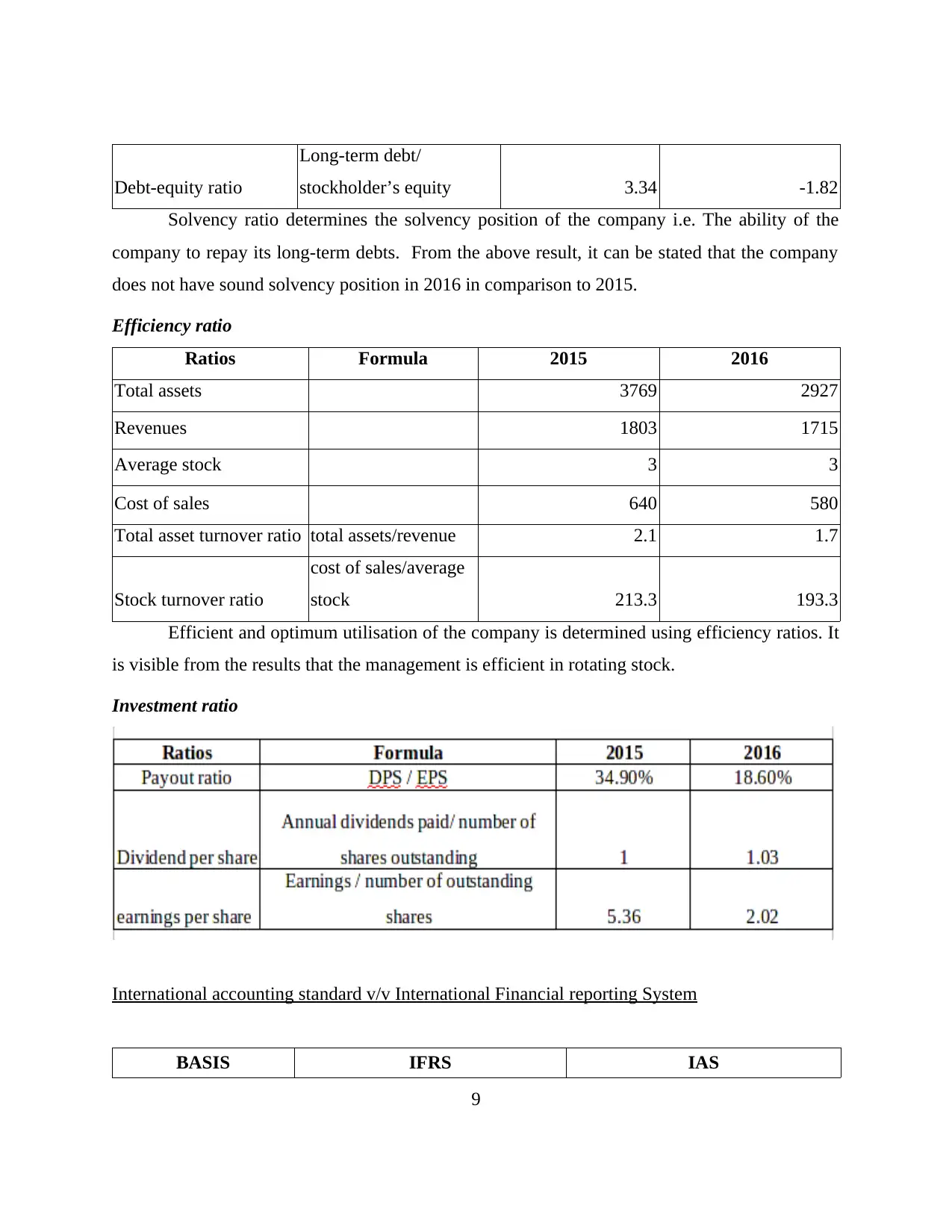
Debt-equity ratio
Long-term debt/
stockholder’s equity 3.34 -1.82
Solvency ratio determines the solvency position of the company i.e. The ability of the
company to repay its long-term debts. From the above result, it can be stated that the company
does not have sound solvency position in 2016 in comparison to 2015.
Efficiency ratio
Ratios Formula 2015 2016
Total assets 3769 2927
Revenues 1803 1715
Average stock 3 3
Cost of sales 640 580
Total asset turnover ratio total assets/revenue 2.1 1.7
Stock turnover ratio
cost of sales/average
stock 213.3 193.3
Efficient and optimum utilisation of the company is determined using efficiency ratios. It
is visible from the results that the management is efficient in rotating stock.
Investment ratio
International accounting standard v/v International Financial reporting System
BASIS IFRS IAS
9
Long-term debt/
stockholder’s equity 3.34 -1.82
Solvency ratio determines the solvency position of the company i.e. The ability of the
company to repay its long-term debts. From the above result, it can be stated that the company
does not have sound solvency position in 2016 in comparison to 2015.
Efficiency ratio
Ratios Formula 2015 2016
Total assets 3769 2927
Revenues 1803 1715
Average stock 3 3
Cost of sales 640 580
Total asset turnover ratio total assets/revenue 2.1 1.7
Stock turnover ratio
cost of sales/average
stock 213.3 193.3
Efficient and optimum utilisation of the company is determined using efficiency ratios. It
is visible from the results that the management is efficient in rotating stock.
Investment ratio
International accounting standard v/v International Financial reporting System
BASIS IFRS IAS
9
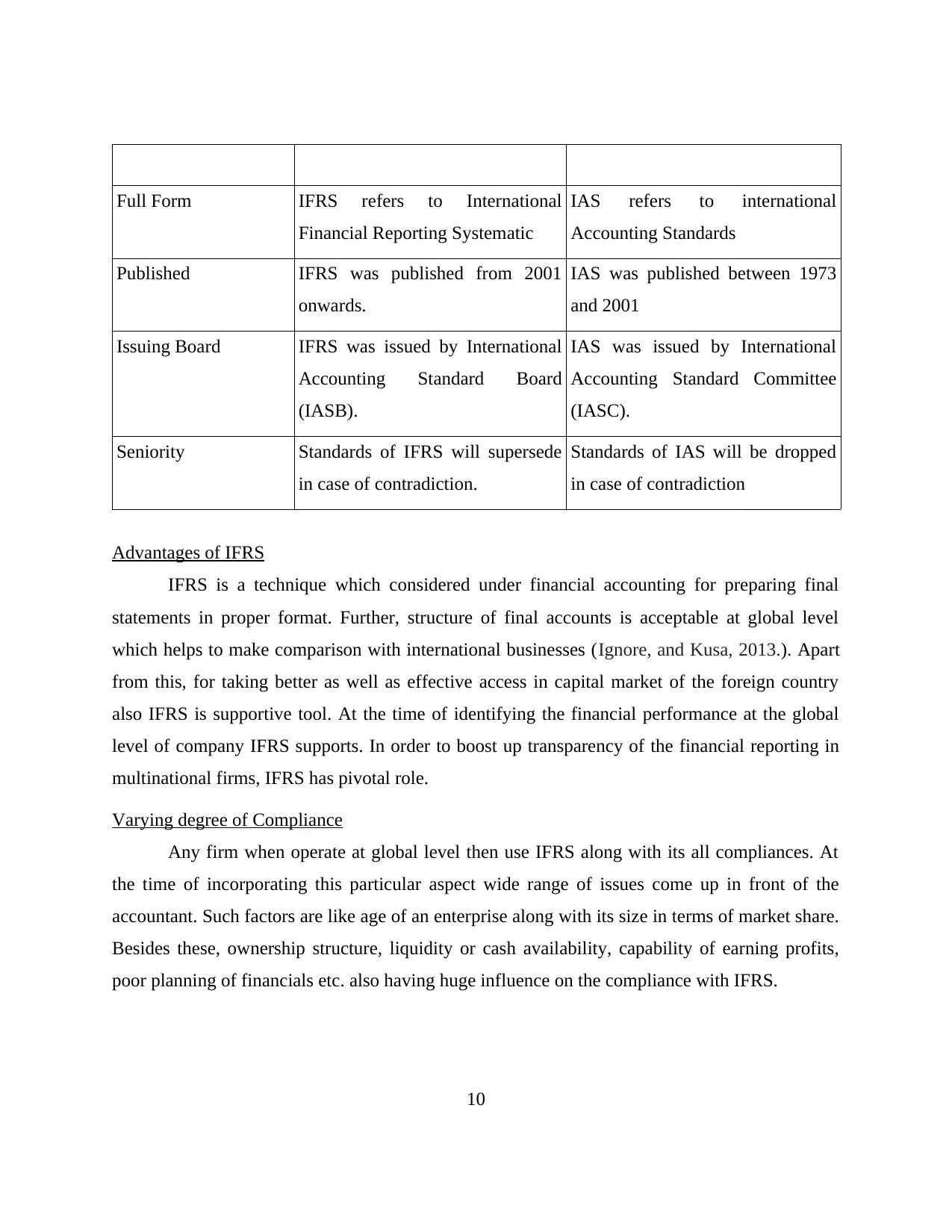
Full Form IFRS refers to International
Financial Reporting Systematic
IAS refers to international
Accounting Standards
Published IFRS was published from 2001
onwards.
IAS was published between 1973
and 2001
Issuing Board IFRS was issued by International
Accounting Standard Board
(IASB).
IAS was issued by International
Accounting Standard Committee
(IASC).
Seniority Standards of IFRS will supersede
in case of contradiction.
Standards of IAS will be dropped
in case of contradiction
Advantages of IFRS
IFRS is a technique which considered under financial accounting for preparing final
statements in proper format. Further, structure of final accounts is acceptable at global level
which helps to make comparison with international businesses (Ignore, and Kusa, 2013.). Apart
from this, for taking better as well as effective access in capital market of the foreign country
also IFRS is supportive tool. At the time of identifying the financial performance at the global
level of company IFRS supports. In order to boost up transparency of the financial reporting in
multinational firms, IFRS has pivotal role.
Varying degree of Compliance
Any firm when operate at global level then use IFRS along with its all compliances. At
the time of incorporating this particular aspect wide range of issues come up in front of the
accountant. Such factors are like age of an enterprise along with its size in terms of market share.
Besides these, ownership structure, liquidity or cash availability, capability of earning profits,
poor planning of financials etc. also having huge influence on the compliance with IFRS.
10
Financial Reporting Systematic
IAS refers to international
Accounting Standards
Published IFRS was published from 2001
onwards.
IAS was published between 1973
and 2001
Issuing Board IFRS was issued by International
Accounting Standard Board
(IASB).
IAS was issued by International
Accounting Standard Committee
(IASC).
Seniority Standards of IFRS will supersede
in case of contradiction.
Standards of IAS will be dropped
in case of contradiction
Advantages of IFRS
IFRS is a technique which considered under financial accounting for preparing final
statements in proper format. Further, structure of final accounts is acceptable at global level
which helps to make comparison with international businesses (Ignore, and Kusa, 2013.). Apart
from this, for taking better as well as effective access in capital market of the foreign country
also IFRS is supportive tool. At the time of identifying the financial performance at the global
level of company IFRS supports. In order to boost up transparency of the financial reporting in
multinational firms, IFRS has pivotal role.
Varying degree of Compliance
Any firm when operate at global level then use IFRS along with its all compliances. At
the time of incorporating this particular aspect wide range of issues come up in front of the
accountant. Such factors are like age of an enterprise along with its size in terms of market share.
Besides these, ownership structure, liquidity or cash availability, capability of earning profits,
poor planning of financials etc. also having huge influence on the compliance with IFRS.
10
⊘ This is a preview!⊘
Do you want full access?
Subscribe today to unlock all pages.

Trusted by 1+ million students worldwide
1 out of 12
Related Documents
Your All-in-One AI-Powered Toolkit for Academic Success.
+13062052269
info@desklib.com
Available 24*7 on WhatsApp / Email
![[object Object]](/_next/static/media/star-bottom.7253800d.svg)
Unlock your academic potential
Copyright © 2020–2025 A2Z Services. All Rights Reserved. Developed and managed by ZUCOL.





